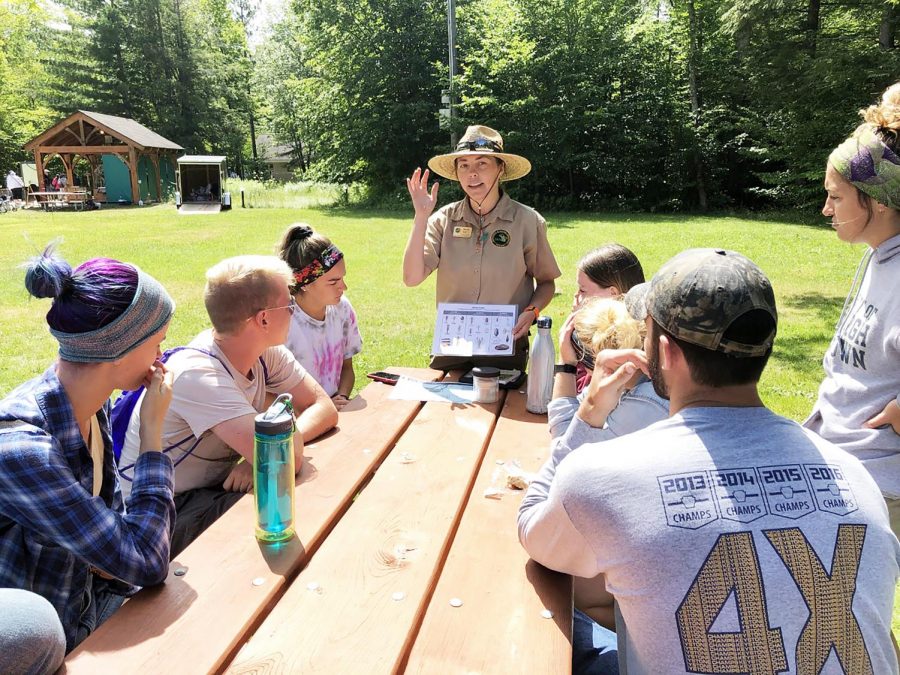Students benefit with field trips, some say
Geography professor Mitzy Schaney lectured to students on a Michigan trip last year.
September 25, 2019
Geography professor Ahmad Massasati said off-campus trips are a valuable tool in providing students with tangible, real-world experiences.
Massasati has been taking students on trips over the course of his Pitt-Johnstown career.
“My favorite trip is to Washington D.C., with my urban development class. I have discovered some students have no idea what the city is like, despite it being one of the most important cities in the world.
“The first time I visited the Capitol, my feelings were overwhelming. I want them to be able to experience that, too,” Massasati said.
“When I tell students that we are going to visit the National Mall, they think we are going shopping. Instead, it is the heart of this nation.”
Massasati said when students leave the classroom, they begin to see deeper connections between what is happening at school and in the world around them.
Geology professor Ryan Kerrigan said he is a strong advocate for field trips and the interests they invoke students.
“The main reason I do this is because, when I was an undergrad, I went to a smaller school like Pitt-Johnstown,” Kerrigan said.
“I had a couple professors who would run trips like this, and that is what got me interested in geology. It’s important for me to recreate the experience that was so impactful in my life for them (his students).”
“Students go to take a cool trip. There are regimented study abroad courses with assignments, but this is different,” Kerrigan said.
“I don’t give them any assignments, although I do force them to listen to me lecture. The worst thing that happens is that they learn a little.
“With the Geology Club, we run trips every spring break. For the past few years, we’ve traveled to locations such as Iceland, Hawaii, Scotland and Ecuador.
“We spend our time looking at natural parks, beautiful mountains, canyons and landscapes. It’s also an opportunity to immerse yourself in the culture of an unfamiliar area,” Kerrigan said.
“It’s been a positive experience for students even with a slight interest in geology. A number of times, they come back as geology majors.”
“Generally, the trips cost students between $700 to $1,500, depending on where we go, which is relatively cheap,” Kerrigan said.
“Geology Club members are currently voting on where we will be going this spring. As we keep doing the trips, we have been generating more club interest.”
“The goal of these trips is to ultimately generate more interest within the field. We want people to come for the fun trips and eventually convert to geology majors,” Kerrigan said.
Geography professor Mitzy Schaney said trip experiences can bring one- dimensional lessons to life and create enthusiasm for a subject that is hard to replicate in the classroom.
“Last March, three of my environmental studies majors and I went to the Mohave Desert as a research trip. We’re hoping to go again this March, but we’re looking for funding.”
“Last year, we paid for it out of pocket,” Schaney said.
“We went through the organization Blueprint Earth, which is a nonprofit designed to give students an opportunity to obtain field research without a cost.
“Once you’re out there, everything is taken care of. When you want to get field experience as an undergrad, you usually are paying for it, so this is a fantastic opportunity,” Schaney said.
“In addition, my environmental science class took a field study trip to Michigan this August.
“Our first stop was a Native American reservoir. Michigan has a rich settlement history,” Schaney said.
“We got a guided tour around the area with a tribal elder and had a lunch there of traditional native foods like wild rice and corn.”
“From there, we went to a national lake shore called Sleeping Bear Dunes.
“We did the dune climb, which is famous in that park. We also worked with park rangers to collect field data on beech bark disease, which is affecting trees in Michigan.”
“The next trip will probably be to the Florida Keys. I like to pick locations based on water activity,” Schaney said.
“The Michigan trip was incredible. I can’t begin to describe how much fun we had, even after two weeks of roughing it outside in tents.”

